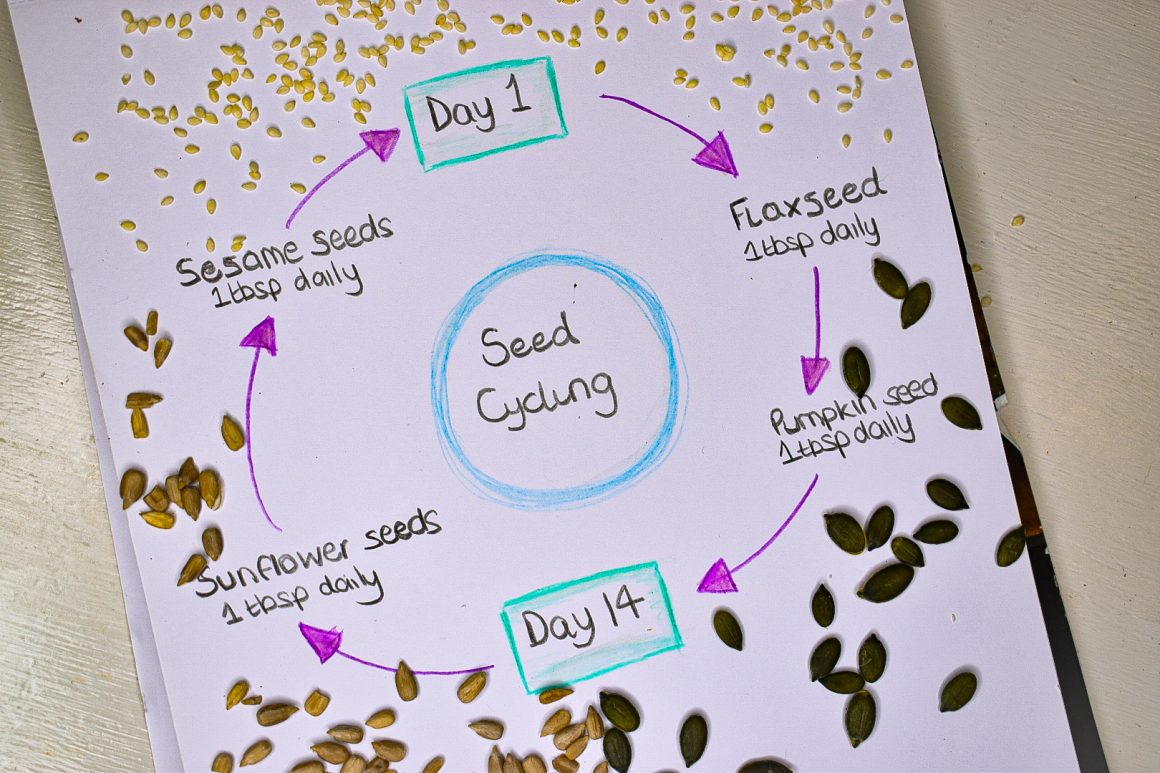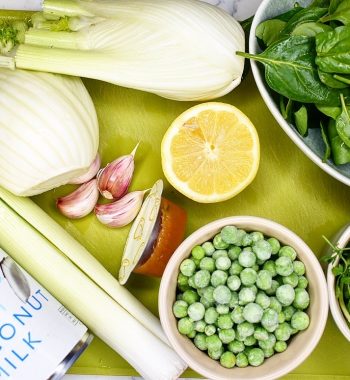
Lets talk about: Seed Cycling
Simply put, the idea is that consuming certain types of seeds at certain times of the month can help to regulate levels of hormones such as progesterone and oestrogen. The theory behind it is that it will help to control symptoms associated with dysregulated hormones. Hormones are amazing and complex and can, quite frankly, be a pain in the ass for a lot of women who suffer with PMS, irregular cycles, painful periods, and hormonal acne – you name it! So, before we jump straight in to everything seed related let’s answer the big ol’ question:
What actually happens throughout the month of menstruation?
Throughout a woman’s cycle there are 4 phases whereby different hormones take centre stage. There are many things happening both at uterine level and ovarian level with a complex interplay of hormones…
Menstrual Phase (Day 1-5)
At the beginning of this phase the uterus is full of nutrients ready to nourish an embryo. If no embryo is present then oestrogen and progesterone drop, causing the uterine lining to shed and menstrual bleeding occurs.
Follicular Phase/Pre-ovulatory Phase (Day 6-13)
In the ovaries, follicle stimulating hormone increases and stimulates the production of follicles (between 3-30 follicles are grown!). Each one of these follicles contains an egg, and as I don’t think there’s ever been report of a human growing 30 babies at once you can probably guess that we narrow it down to just 1 (aptly named the dominant follicle). The growth of this follicle causes an increase in oestrogen and luteinizing hormone – told you it was a minefield of hormone changes.
This surge of luteinizing hormone marks the start of ovulation and the end of the follicular phase.
Ovulatory Phase (Day 14)
The increase in luteinizing hormone basically stimulates the burst of the dominant follicle and for an egg to be released.
Ovulation can last anything between 16-32 hours; and the egg can only be fertilised for 12 hours after it’s been released – so it’s a surprisingly small window of opportunity for pregnancy to occur!
During this phase, some women can suffer with pain in one side of their stomach, this is usually felt on the same side as the ovary that released an egg. So, if you’ve ever said ‘I’ve got ovary pain’ you’re not that wrong.
Luteal Phase/Post Ovulatory Phase (Day 15-28)
This is the time between ovulation and your next period. The follicle that released an egg closes and forms a structure called the corpus luteum. This releases progesterone. The reason for this increase in progesterone is to prepare the uterus for an embryo and cause the endometrium to thicken to provide nutrients for a potential embryo. We are constantly preparing ourselves for babies and if and when this doesn’t happen the menstrual phase starts again – lucky us eh?
Although around 26% of the global population are of reproductive age there can be a lack of knowledge surrounding the intricacies of our menstrual cycle, and still a lot of stigma around it. I was shocked when I studied the menstrual cycle that I knew very little about the different phases and what is actually happening within the body – which is crazy considering it’s something we endure every month!
So now I’ve given a simple breakdown of what our amazing little bodies are actually doing at the ‘time of the month’, how on earth can seeds help? Is it another nutri-fad?
Seed Cycling:
As I’ve outlined above, different hormones are needed at different times of the month. Seed cycling aims to support a women’s menstrual cycle and hormones by providing the nutrients they need at the specific phase in their cycle. Seed cycling aims to regulate oestrogen in the first half of the cycle and progesterone in the second half.
Flaxseeds:
Contain phytoestrogens which can help increase oestrogen levels if they are too low or decrease them if they get too high. They’re also high in omega 3s which can act as an anti-inflammatory.
Pumpkin Seeds:
Provide a good source of zinc which contributes to the body’s ability to produce and regulate progesterone
Sesame Seeds:
High in zinc. They contain phytoestrogens called Lignans which can prevent oestrogen getting too high.
Sunflower Seeds:
Contain vitamin E which is thought to help increase progesterone levels
How do I cycle?
During days 1-14 of your cycle:
- consume 1 tbsp ground flaxseeds and 1 tbsp pumpkin seeds each day
- You can add them to smoothies, salads, porridge, yoghurt, or make a homemade trail mix
During days 15-28 of your cycle:
- Consume 1 tbsp sunflower seeds and 1tbsp sesame seeds per day
- You can add them to smoothies, salads, porridge, yoghurt, or make a homemade trail mix

Who should cycle?
Seed cycling is said to have benefits for those with irregular cycles, PMS, endometriosis, polycystic ovaries, period associated breast pain as well as to help relieve some of the symptoms of the menopauses (hot flushes).
Is it just a load of nutri bollocks?
Ah that age-old question. I can’t fully answer this because there isn’t a body of scientific research devoted to seed cycling yet. There is a need for evidence based studies in this area before we can say it is a fully effective way of supporting hormone balance. It’s also one of those areas that gets touted as being some miracle cure without any scientific backing. Unfortunately, platforms like social media have given rise to all sorts of meaningless and unfounded claims. However, in this case there are LOTS of proven health and nutritional benefits associated with the individual seeds involved in seed cycling. So, whether or not there’s scientific research about the concept seed cycling you’re bound to get some of the goodness from the seeds regardless, right? It’s also not too difficult to chuck a tablespoon of seeds into your smoothie or salad and assess whether it works for you?
Every person is different, and menstrual cycles are extremely personal. But we all know how frustrating and upsetting it can be when we suffer with hormonal imbalances or painful periods and there’s more whacky things out there than a tablespoon of seeds everyday – trust me.





